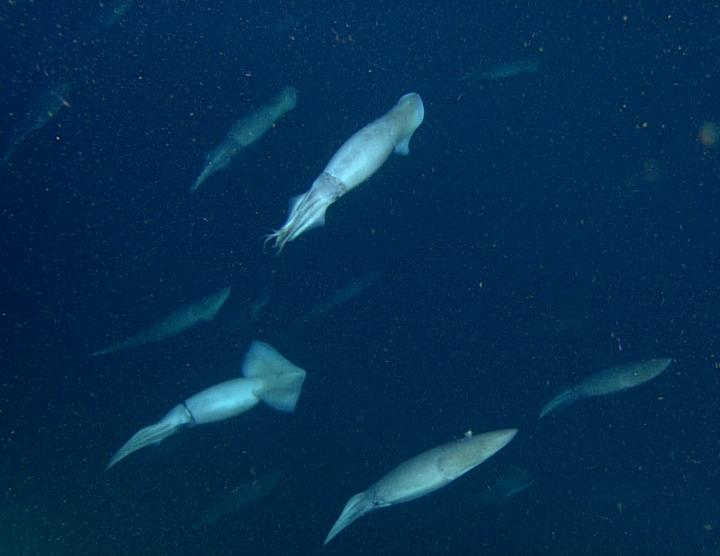

A group of Humboldt squid swim information about 200 meters below the surface of Monterey Bay.
Credit: © 2010 MBARI
How do they establish such order in the near-darkness of the ocean's twilight zone?
The answer, according to researchers from Stanford University and the Monterey Bay Aquarium Research Institute (MBARI) may be visual communication.
Like the illuminated words on an e-book reader, these researchers suggest that the squid's ability to subtly glow – using light-producing organs in their muscles – can create a backlight for shifting pigmentation patterns on their skin. The creatures may be using these changing patterns to signal one another.
The research is published March 23 in the journal Proceedings of the National Academy of Sciences.
“Many squid live in fairly shallow water and don't have these light-producing organs, so it's possible this is a key evolutionary innovation for being able to inhabit the open ocean,” said Benjamin Burford, a graduate student in biology in the School of Humanities and Sciences at Stanford and lead author of the paper.
“Maybe they need this ability to glow and display these pigmentation patterns to facilitate group behaviors in order to survive out there.”
Seeing the deep sea
Humboldt squid behavior is nearly impossible to study in captivity, so researchers must meet them where they live. For this research, Bruce Robison of MBARI, who is senior author of the paper, captured footage of Humboldt squid off the coast of California using remotely operated vehicles (ROVs), or unmanned, robotic submarines.
While the ROVs could record the squid's skin patterning, the lights the cameras required were too bright to record their subtle glow, so the researchers couldn't test their backlighting hypothesis directly. Instead, they found supporting evidence for it in their anatomical studies of captured squid.
Using the ROV footage, the researchers analyzed how individual squid behaved when they were feeding versus when they were not. They also paid attention to how these behaviors changed depending on the number of other squid in the immediate area – after all, people communicate differently if they are speaking with friends versus a large audience.
The footage confirmed that squid's pigmentation patterns do seem to relate to specific contexts. Some patterns were detailed enough to imply that the squid may be communicating precise messages – such as “that fish over there is mine.”
There was also evidence that their behaviors could be broken down into distinct units that the squid recombine to form different messages, like letters in the alphabet. Still, the researchers emphasize that it is too early to conclude whether the squid communications constitute a human-like language.
“Right now, as we speak, there are probably squid signaling each other in the deep ocean,” said Burford, who is affiliated with the Denny lab at Stanford's Hopkins Marine Station. “And who knows what kind of information they're saying and what kind of decisions they're making based on that information?”
Although these squid can see well in dim light, their vision is probably not especially sharp, so the researchers speculated that the light-producing organs help facilitate the squid's visual communications by boosting the contrast for their skin patterning. They investigated this hypothesis by mapping where these light organs are located in Humboldt squid and comparing that to where the most detailed skin patterns appear on the creatures.
They found that the areas where the illuminating organs were most densely packed – such as a small area between the squid's eyes and the thin edge of their fins – corresponded to those where the most intricate patterns occurred.
Familiar aliens
In the time since the squid were filmed, ROV technology has advanced enough that the team could directly view their backlighting hypothesis in action the next time the squid are observed in California. Burford would also like to create some sort of virtual squid that the team could project in front of real squid to see how they respond to the cyber-squid's patterns and movements.
The researchers are thrilled with what they have found so far but eager to do further research in the deep sea. Although studying the inhabitants of the deep sea where they live can be a frustratingly difficult endeavor, this research has the potential to inform a new understanmetimes think of squid as crazy lifeforms living in this alien world but we have a lot in common – they live in groups, they're social, they talkding of how life functions.
“We so to one another,” Burford said. “Researching their behavior and that of other residents of the deep sea is important for learning how life may exist in alien environments, but it also tells us more generally about the strategies used in extreme environments on our own planet.”
###
This work was funded by the David and Lucile Packard Foundation and the Department of Biology at Stanford.















